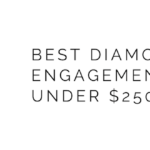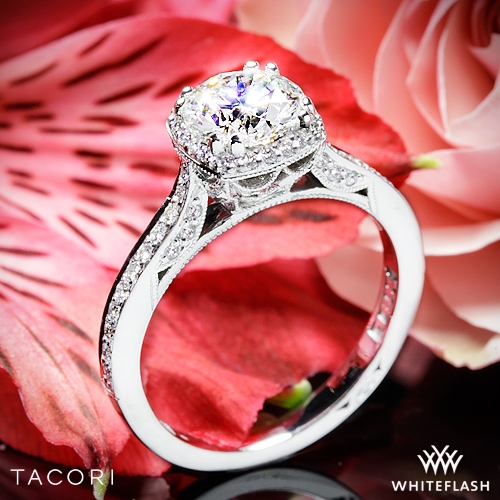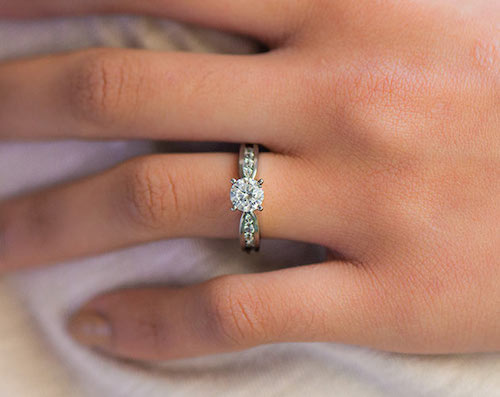
1 vs 2 Carat Diamonds: Full Comparison
March 17, 2023
Best Diamond Engagement Rings Under $2500: A Comprehensive Guide
August 10, 2023The Ultimate $5,000 Diamond Ring Buying Guide

Diamonds are not just a girl’s best friend, they’re also a symbol of promise, commitment, and the journey of love. However, when it comes to purchasing a diamond ring, particularly with a budget of around $5,000, the decision-making process can become quite overwhelming. With so many options, each with its own specifications and prices, it’s easy to get lost in the dazzling world of these precious gems.
Our comprehensive guide to buying a $5,000 diamond ring is here to help. Whether you’re a first-time buyer or an experienced gem enthusiast, we’ve got you covered. In this guide, we’ll navigate the fascinating intricacies of diamond quality, different shapes, types, and settings, and even delve into the cost-effective and ethical choice of lab diamonds.
From understanding the classic “Four Cs” of diamond grading – Carat, Cut, Clarity, and Color – to how to maximize your budget and choose the right setting that complements your selected diamond, we’ll equip you with all the necessary information to make an informed and confident decision.
Moreover, we will provide a handy chart comparing average prices for popular diamond shapes paired with a $1,000 setting, to help you find the perfect match within your budget.
Embark on this journey with us, to select a diamond ring that’s not just a piece of jewelry, but a reflection of your taste, values, and the bond you share with your loved one. Welcome to our $5,000 Diamond Ring Buying Guide.
Summary:
- Understanding the 4Cs
- Budgeting for Your Ring
- Lab Diamonds Vs. Natural Diamonds
- Choosing the Right Setting
- Diamond Shapes and Pricing
- Conclusion
Understanding the 4Cs
When purchasing a diamond, it’s essential to understand the 4Cs: Carat, Cut, Clarity, and Color. These four attributes collectively determine a diamond’s quality and price. Here’s a brief look at what each of them means:
- Carat: This is the weight of the diamond. Larger diamonds are rarer and therefore more expensive. However, the perceived size of a diamond can also depend on its shape and how it’s set in the ring.
- Cut: The cut of a diamond doesn’t refer to its shape, but rather how well it has been cut from its rough form. Aspects like symmetry, proportions, and polish are considered. A well-cut diamond will reflect light beautifully, contributing to its brilliance.
- Clarity: Clarity assesses the internal and external imperfections, known as inclusions and blemishes respectively. Diamonds with fewer flaws have a higher clarity grade and are more valuable. However, many imperfections can’t be seen by the naked eye.
- Color: This refers to the presence of any color in a diamond. The Gemological Institute of America (GIA) and IGI grades diamond color on a scale of D (colorless) to Z (light yellow or brown). Diamonds closer to D are more valuable.
Remember, each of these factors plays a significant role in a diamond’s appearance and cost. While it might be tempting to prioritize one over the others, finding a balance between all four will help you get the best diamond for your budget.
Budgeting for Your Ring
When it comes to buying a diamond ring, budgeting is an important aspect of the process. Your budget should reflect not only what you can comfortably afford, but also what aspects of the ring are most important to you. Here are some key factors to consider:
- Understand the Market: Familiarize yourself with the current diamond market and the typical cost of the style, size, and quality of the diamond you’re interested in. This will help you create a realistic budget.
- Balance the 4Cs: Prioritize what’s most important to you among the 4Cs—Carat, Cut, Clarity, and Color. In my opinion cut should be your main priority!
- Consider the Setting: The ring setting can significantly influence the overall price of the ring. Different materials (platinum, gold, white gold, etc.) and styles (solitaire, halo, pavé, etc.) vary in price. Remember to factor this into your budget.
- Factor in Extra Costs: Don’t forget about potential extra costs such as sales tax, insurance, or any customizations to the design of the ring.
- Consider Financing Options: Many jewelers offer financing plans that can help spread the cost over a period of time. Be sure to understand the terms and interest rates before opting for financing.
Remember, the goal is to purchase a diamond ring that you love and can afford, without overstretching your budget. By carefully considering each aspect and making informed decisions, you can find a beautiful ring that fits within your $5,000 budget.
Lab Diamonds Vs. Natural Diamonds
One of the biggest decisions you’ll face when purchasing a diamond ring is choosing between a lab-grown diamond and a natural diamond. While both options have their own unique attributes and benefits, your final decision could significantly impact the cost of your ring. Here’s what you need to know:
- Natural Diamonds: These are formed over billions of years under high pressure and heat conditions deep within the Earth. Each natural diamond is unique and comes with its own set of characteristics, which can add to its appeal. In terms of cost, natural diamonds are generally more expensive than lab-grown diamonds of the same size and quality, primarily due to the lengthy and complex process required to mine, cut, and polish them.
- Lab-Grown Diamonds: Also known as synthetic or man-made diamonds, these are created in a laboratory using high-pressure high-temperature (HPHT) or chemical vapor deposition (CVD) methods. These processes replicate the natural conditions under which diamonds form, but over a much shorter period of time. Lab-grown diamonds possess the same physical, chemical, and optical properties as natural diamonds. The primary difference lies in their origin. Because they’re less resource-intensive to produce, lab-grown diamonds are often priced lower than natural diamonds. This means you might be able to afford a larger or higher quality lab-grown diamond for the same price as a smaller or lower quality natural diamond.
Whether you choose a natural or lab-grown diamond largely depends on your personal preferences and budget. If you’re attracted by the allure and timeless charm of natural diamonds and have the budget for it, a natural diamond could be the right choice for you. On the other hand, if size or quality is your priority and you’re looking for a more budget-friendly option, you might find that a lab-grown diamond meets your needs perfectly. Ultimately, both natural and lab-grown diamonds can make for a stunning centerpiece in a diamond ring.
Choosing the Right Setting
Choosing the right setting for your diamond ring is just as important as choosing the diamond itself. The setting not only influences the overall look and style of your ring, but it also plays a significant role in how the diamond is showcased. Here are a few types of settings and some tips to keep in mind:
- Prong Setting: This is the most common type of setting, where the diamond is held in place by metal prongs. A prong setting allows a lot of light to pass through the diamond, enhancing its brilliance. Image recommendation: A close-up shot of a prong-set diamond ring.
- Bezel Setting: In a bezel setting, a metal rim surrounds the diamond. This setting style is modern and protects the diamond well, making it a good choice for those with an active lifestyle. Image recommendation: A side view of a bezel-set diamond ring showing the metal rim.
- Halo Setting: A halo setting features a center diamond surrounded by smaller diamonds. This setting can make the center diamond appear larger and adds extra sparkle to the ring. Image recommendation: A top view of a halo-set diamond ring showing the surrounding smaller diamonds.
- Pavé Setting: Pavé (pronounced “pah-vay”) setting involves setting small diamonds closely together on the band, which gives the appearance of a continuous sparkle. Image recommendation: A close-up of a pavé-set band showing the small diamonds.
Here are some tips to consider when choosing your setting:
- Match the Setting to Your Lifestyle: If you or the person you’re buying the ring for leads an active lifestyle, consider a setting that provides more protection to the diamond, like a bezel setting.
- Consider the Diamond Shape and Size: Some settings work better with certain diamond shapes and sizes. For example, a prong setting is versatile and works with most shapes, while a halo setting can make a small diamond appear larger.
- Think About Maintenance: Some settings require more cleaning and maintenance than others. Prong settings, for example, should be checked regularly to ensure the prongs haven’t loosened.
Remember, the setting will contribute to the overall cost of the ring. Keep your budget in mind and be sure to factor in the cost of the setting when choosing your diamond.
Diamond Shapes and Pricing
The shape of your diamond is a significant aspect that not only determines the aesthetics of your ring but also impacts the price. Different shapes offer different visual effects, and each shape may appeal to different personal styles. Below are some of the most popular diamond shapes:
- Round: The most popular shape, round diamonds are valued for their classic and timeless appeal. Their symmetric shape allows for maximum reflection of light, leading to exceptional brilliance.
- Princess: Known for their modern, chic appearance, princess cut diamonds are shaped like a square or rectangle from the top view, and their facets produce a high level of sparkle.
- Cushion: With rounded corners and larger facets, cushion cut diamonds have a vintage charm. They are designed to highlight the diamond’s clarity and can appear slightly larger than other shapes of the same carat.
- Oval: Oval diamonds offer a modern twist on the classic round shape. They create an illusion of greater size, and their elongated shape can make the wearer’s fingers appear slimmer.
- Marquise: With a football-like shape, marquise diamonds are distinctive and striking. Their elongated shape maximizes carat weight, making them appear larger than other shapes of the same carat size.
- Pear: Resembling a teardrop, pear-shaped diamonds are a blend of round and marquise shapes. This unique shape stands out and gives a slenderizing effect to the fingers.
- Emerald: Known for their elegance, emerald cut diamonds have rectangular facets and trimmed corners. They emphasize clarity more than the sparkle of the diamond.
- Asscher: Similar to the emerald cut but in a square shape, Asscher cut diamonds are distinctive and vintage. They have a unique ‘X’ pattern when viewed from the top.
- Radiant: Combining the stylish lines of the emerald cut with the brilliance of the round cut, radiant cut diamonds are vibrant and versatile. They hide inclusions well and work in many types of settings.
💎 Desire a High-Quality Diamond for Under $5000? Consider Lab-Grown Diamonds! 💎
Experience the brilliance of a larger, certified diamond without stretching your budget. Lab-grown diamonds offer the same dazzle and beauty as natural diamonds, but at a much lower cost.
Why compromise on size? With lab-grown diamonds, you can afford a stunning 1.5 to 2 carat diamond instead of settling for a 70-point one.
Consider Whiteflash, James Allen and Blue Nile for lab grown diamonds.
When selecting your diamond shape, it’s important to consider both your personal style and your budget. Different shapes come with different price tags, so understanding how shape affects the price can help you make the best decision within your budget.
Conclusion
Choosing the perfect diamond ring is a significant decision. It requires understanding a variety of factors and making well-informed choices that align with your personal preferences and budget. From learning about the 4Cs to deciding between a lab-grown or natural diamond, from selecting the right setting to understanding how different diamond shapes affect price, every aspect plays a crucial role in finding a diamond ring that you’ll cherish.
It’s essential to remember that while there’s a wealth of information and guidelines available, the best diamond ring is one that feels right for you or the person you’re buying it for. At the end of the day, beauty is subjective, and a diamond’s value lies in the joy it brings.
Whether you’re drawn to the traditional charm of a round diamond, the modern elegance of a princess cut, or the unique allure of a pear-shaped diamond; whether you prefer the timeless journey of a natural diamond or the impressive size and quality of a lab-grown diamond within the same budget, your perfect diamond ring is an embodiment of your individual taste and story.
This guide aims to equip you with the knowledge you need to navigate your diamond ring purchase with confidence. Remember, it’s not just about buying a piece of jewelry; it’s about investing in a symbol of enduring love and commitment. So, as you embark on this exciting journey to find your perfect $5,000 diamond ring, take your time, trust your instincts, and enjoy the process. After all, every love story is unique, and so should be every diamond ring.




